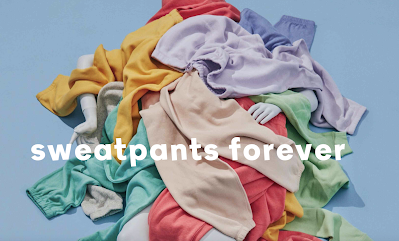Getting and Spending: Unisex is the new old thing
One term from the '70s, unisex, and one from 2020 or so: DTC (Direct to Consumer): such are the changes in play, and big changes they are.
For a revealing (but lengthy) essay on the economics of fashion, see Irina Alexsander's New York Times article, "Sweatpants Forever", which is not particularly about the pants.
 |
| Photo: New York Times |
The apparel industry has been in a death spiral for years: too much inventory, but not enough profit to reliably pay the designers who have long sold their goods to department stores and boutiques under an odious arrangement that allowed stores to return unsold goods and be reimbursed (if they had ever paid for them).
You must have noticed that stores had the next season's clothes ever earlier; summer showed up in mid-February or early March.
Molly Nutter, a former VP of merchandising at Barney's, explains it succinctly: “The system has been broken for a long time... There was a lot of pressure on designers to produce more collections, and therefore more product... It wasn’t a real demand by the customer; I think it was just retailers trying to grab market share. They thought, If I can get more in, and earlier, then I can get more clients through my door. But with everyone doing this, it just compounds the problem."
And, it was not all going on sale. Burberry, according to Nutter, burned $37 million of clothing a year to retain "brand value". And if you bought Burberry, you paid a share of that fire.
 |
| Photo: Entireworld.com |
One of the changes is the rise of the DTC model: selling direct to the consumer, instead of through boutiques or department stores. If you've clicked on an Instagram ad and bought, or shop companies like Everlane or Entireworld, you're in that new reality. Brands once strictly mail-order (the old-school term) have abandoned their experiments with stores; J. Crew has 'rejected' 57 store leases since June.
On DTC sites or in their remaining handful of stores, you are in a land that features a good shot of perennial basics (sweats, tees, socks, crew-necks)—check any Everlane splash page from 2014 to now and guess what year you're looking at. You'll also find a small seasonal selection (puffers, linen shirts) and the occasional collab with a hot designer. like Uniqlo's with Jil Sander.
 |
| J. Crew unisex cotton rollneck |
A number of DTC vendors are offering unisex clothes. Unisex had its last moment in the '70s, when Carhartt work jackets, that J. Crew roll-neck and Fruit of the Loom white tees were marketed to everyone. Not all designers embraced it; Calvin Klein said "Unisex means no sex."
Case study: Unisex and sole-sex clothes. Below, unisex:
 |
| Unisex |
Left: Kotn rose taupe Work Shirt. The site instructs women to order one size down.
Right: Entireworld Dog Walker coat. The copy says, "This is technically a dude’s jacket and is sized accordingly, but it’s just perfect for the ladies if you size down." It is cotton with a poly filling, but go figure, dry clean only. Might be because it has recycled paper buttons. WTF? (What The Finishing?)
Now let's look at clothes made for women, also from DTC vendors:
 |
| Women's |
Left: Madewell corduroy Sunday Shirt, s/o in the rose dust colour, but I'm showing because it's a nearly identical shirt cut for a woman. Note the side pockets; there is also a back yoke (not shown) and a narrower wristband. I can't swear to it, but the arm looks more highly-set.
Right: J. Crew padded Field Jacket, more fitted than the Dogwalker thanks to the back tabs. The sleeves do not have to be rolled and there's a Primaloft filling but this jacket, nearly the same price, is washable.
Value proposition: You pay the same price for unisex as for comparable gender-specific clothing, so wear what you dig—but I will opt for a shirt that does not have an upper back cut 4 inches wider than I need.
In my twenties, I bought men's Levis, surplus-store army jackets, and Roots sweatpants that were (as my then-boyfriend said) one-size-fits-no one. Now, I want clothes that know from a bust and hips—they just feel better.
A fond mask-snap to those who have lobbied for inclusive sizing. We may need fewer pieces produced, but at the same time, why settle for something that covers as if you're a piece of draped furniture? When we put on something that feels like our body is not just accommodated but celebrated, that's a lovely sensation.



Comments
I too read that NYT article, it was eye-opening.
My recent experience of DTC was Allbirds short socks. After searching local sock stores for something attractive that wouldn't cause my legs to swell, I found these. They fit the bill, highly recommend. https://www.allbirds.ca/products/trino-tm-quarters-seafoam
Leslie M: I cannot stand sweat pants on me, but others can look jaunty. Also, I hate putting clothes in the dryer and sweats can take days to dry.
I like a high-spandex pant, often called "techno" fabric. Mine are by Lisette, a Montréal maker. They pull on, with one of those waistbands that hug but does not constrict, like yoga pants. I have worn the Lisette ankle pant and the true straight pant. I also like jeans with 3% spandex (NYDJ is one maker). But in summer that much spandex is just too hot.
Other women like LL Bean Perfect Pants, which have a whopping 10% lycra and come in various neutrals and a wide size range.